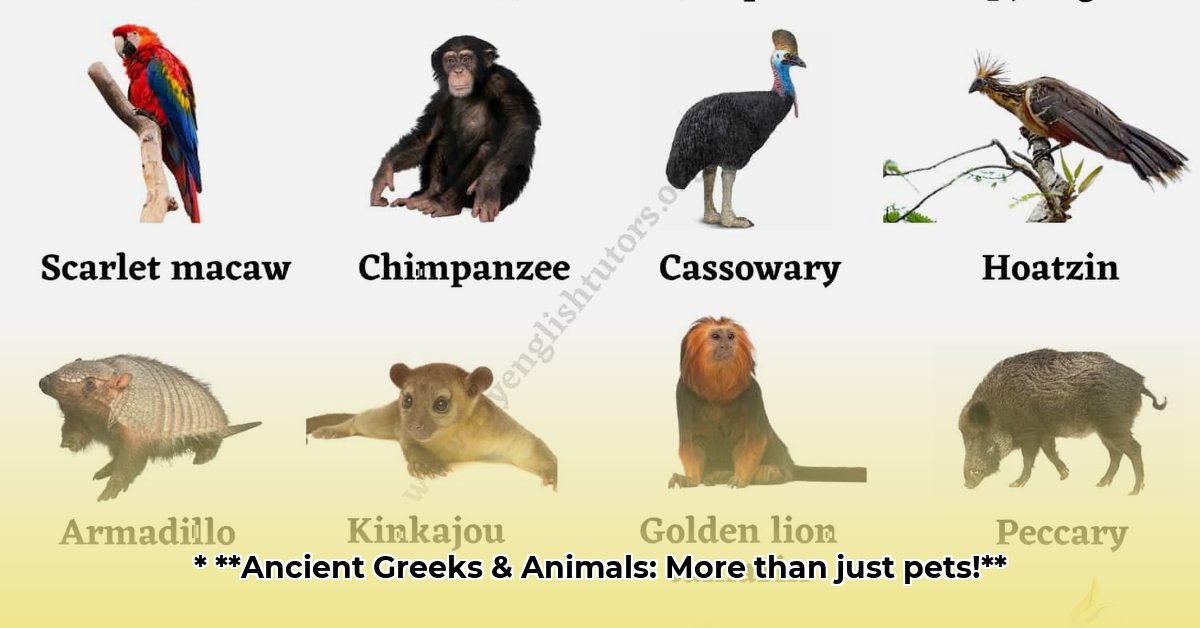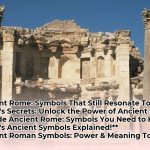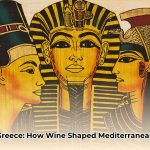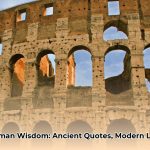Ever pondered the living backdrop of classical antiquity beyond the philosophers, grand temples, and epic battlefields? Ancient Greece, a cradle of Western civilization, was also a bustling stage for a diverse array of animals. These creatures were far more than mere inhabitants; they were integral to the daily grind, the economy, the very fabric of society, and even the spiritual beliefs that shaped a foundational culture. From the beasts of burden transforming landscapes to the cherished companions sharing hearth and home, animals exerted an undeniable, often symbolic, influence that profoundly shaped the ancient world. Want to learn more about Ancient Greece symbols?
Beasts of Burden: Powering a Civilization
Life in ancient Greece demanded immense physical strength and resilience, much of which was tirelessly provided by its animal inhabitants. Imagine the monumental tasks undertaken without modern machinery; it was animal power, ingeniously harnessed, that made civilization possible and allowed communities to flourish.
- Oxen: These formidable creatures were the heavy lifters of their era, indispensable for agriculture. They tirelessly pulled plows through fields, enabling the widespread cultivation of crops essential for sustenance. Indeed, the prosperity of many early Greek communities hinged directly on the labor provided by their oxen. So vital were they that before the introduction of coinage, cattle served as a fundamental measure of wealth, even being exchanged in dowries. The poet Hesiod underscored this importance, advising, “First of all, get a house, and a woman, and an ox for the plough.” In Athens, the ritualistic Bouphonia sacrifice, involving an ox, even required a mock trial to absolve participants of guilt, highlighting their immense societal value.
- Horses: Beyond their elegance, horses were critical for mobility and military might. They facilitated rapid transportation across varied terrains and were pivotal in warfare, pulling chariots and carrying cavalry into crucial battles. The Nisean breed, for instance, was famed throughout the ancient world for its qualities. Owning horses also conferred significant social status, akin to possessing luxury conveyances in contemporary society, with the hippeis (horse-owning class) holding considerable power. Horse races were prominent features of the Olympic Games, celebrating both equine athleticism and human mastery, and their pervasive presence in myths and legends further cemented their cultural significance.
- Donkeys: Often overshadowed, donkeys were the quintessential pack animals. Their endurance allowed for the transport of vital goods, from foodstuffs to construction materials, across challenging landscapes. Their humble utility underscored their pervasive presence in daily commerce and labor, particularly in mountainous regions.
- Dogs: While also cherished as pets, dogs served vital practical purposes. They were indispensable as skilled hunting partners, renowned for their tracking abilities, and vigilant guardians of homes and livestock against predators like wolves. Ancient Greeks even fashioned spiked collars to protect their canine protectors, demonstrating their ingenuity and concern for their well-being.
From Farm to Feast: Animals as Sustenance
The ancient Greek diet, while heavily reliant on grains, olives, and cheese, was significantly supplemented by animal products. Animals provided not only meat but also milk, wool, and, crucially, honey.
- Sheep & Goats: The backbone of ancient Greek sustenance and trade, these animals provided essential resources. Wool from sheep was vital for textiles, while both offered milk (often from goats, as cows were rarely milked) and meat, forming staples of the ancient diet. Their widespread rearing made them an invaluable economic asset, sustaining communities through their diverse yields. Lamb, pork, and goat were common meats.
- Pigs: A primary source of protein, pigs were relatively easy to raise and featured prominently in Greek cuisine. They were a common sight at feasts and celebrations, symbolizing abundance and contributing significantly to the caloric intake of the populace.
- Poultry: Birds like chickens, ducks, and geese were domesticated and consumed. Flamingo tongues were a highly valuable delicacy in ancient Rome, even collected by emperors for feasts, showing a cross-cultural culinary appeal. Pheasants, guinea fowl, and partridges were farmed, with partridges believed to aid those with dysentery. Quails were hunted and eaten since antiquity, and ostrich eggs, though rare, were also consumed. Peacocks and peahens were eaten, often sacrificed to Juno.
- Fish and Seafood: Given Greece’s extensive coastline, fish and seafood were essential. Tuna, sturgeon, mackerel, anchovies, lobsters, oysters, mussels, and octopus were popular. Garum, a popular Roman condiment, was made from fish. Lobsters were considered prestigious food, and octopus were sometimes given as gifts. Ancient fishermen used nets, short rods, traps, and lines with hooks, some with artificial flies. Spearfishing with tridents (like Poseidon’s) was also practiced. Thriving fish markets existed across the Roman world. Whaling, a dangerous practice, was also conducted, with the ancient Greeks and Romans hunting sperm and killer whales near Corsica, Sardinia, and the Peloponnese. Seaweed, known as alga or phycos, was used as medicine for gout and ankle swelling, and as a soil fertilizer.
- Bees: Before the advent of refined sugars, honey from bees was the primary sweetener, prized for its taste and its role in religious rituals. Beekeeping was a respected skill, yielding a valuable commodity that influenced both diet and religious practices. Did you know honey was occasionally offered to the gods, highlighting its profound cultural importance?
Echoes of Divinity: Animal Symbolism and Mythology
The practical contributions of animals were matched by their profound symbolic weight in the Greek worldview. They served as conduits to the divine, embodying traits and representing the very essence of deities, weaving themselves deeply into mythology and religious practices.
- Zeus (King of the Gods):
- Eagle: This majestic bird, revered for its strength and soaring flight, became Zeus’s personal emblem, symbolizing his dominion over the skies, supreme power, authority, and triumphant victory. Zeus famously took the form of an eagle to abduct Ganymede.
- Bull: A symbol of immense power, masculinity, and fertility, the bull represented Zeus’s ability to transform and assert his will, most notably when abducting Europa.
- Hera (Queen of the Gods, Goddess of Marriage):
- Peacock: With its stunning feathers, the peacock represented Hera’s beauty and her status as the queen. Its eye-like patterns symbolized her watchful nature over women and marriage.
- Cuckoo: Unique to Hera’s story, the cuckoo symbolized her union with Zeus, as he transformed into one to win her affection.
- Cow: Symbolizing motherhood and fertility, the cow was sacred to Hera, aligning with her nurturing role.
- Poseidon (God of the Sea, Earthquakes, Horses):
- Horse: A creature of strength and elegance, the horse symbolized Poseidon’s power and gift to humanity. He was sometimes depicted creating horses or fathering mythical ones like Pegasus.
- Dolphin: Representing the gentler side of his realm, dolphins embodied Poseidon’s role as guardian of marine life.
- Cretan Bull: Linked to Poseidon’s influence over the Minoan civilization, this bull showcased his power to both support and challenge human endeavors.
- Athena (Goddess of Wisdom, Strategic Warfare):
- Owl: Revered as the companion of Athena, the owl became a potent symbol of wisdom, keen insight, and a vigilant disposition. Its iconic image frequently adorned Athenian coinage, signifying the city-state’s dedication to intellect. The Acropolis was a safe haven for them, and they were believed to protect soldiers and even foretell weather.
- Apollo (God of Music, Prophecy, Healing, Arts):
- Cow: Associated through the myth of his sacred cattle, representing nourishment and prosperity.
- Hawk & Crow/Raven: Seen as messengers for Apollo, symbolizing his role as a god of prophecy and keen sight.
- Snake: Significant symbol for Apollo, representing his victory over the serpent Python, leading to the establishment of his oracle at Delphi.
- Cicada & Swan: Associated with Apollo’s domain over music and poetry, symbolizing melodious song and poetic inspiration.
- Artemis (Goddess of the Hunt, Wilderness):
- Deer: A graceful and swift animal, sacred to Artemis, symbolizing her skill as a huntress and connection to the wilderness.
- Wild Boar: A formidable and challenging prey, highlighting Artemis’s role as a goddess of protection and challenge in the wild.
- Hermes (Messenger of the Gods, Patron of Travelers):
- Tortoise: Holds a unique place, as Hermes created the first lyre from a tortoise shell, symbolizing his inventiveness.
- Ram: Symbolizes protection and ingenuity, reflecting Hermes’s role as a guardian.
- Ares (God of War):
- Dog: Known for loyalty and ferocity, representing the dual aspects of a warrior’s nature.
- Vulture: A scavenger of battlefields, symbolizing war’s aftermath and death’s inevitability.
- Boar: Fierce and formidable, symbolizing the brutality and intensity of warfare.
- Demeter (Goddess of Agriculture, Harvest):
- Serpent: Associated with cycles of life and death, symbolizing fertility and the earth’s renewal.
- Pig: Linked to fertility and abundance, often sacrificed in rituals to ensure a fruitful harvest.
- Hades (Ruler of the Underworld):
- Black Ram: Symbolizes death’s finality and the underworld’s solemnity.
- Screeching Owl: Often associated with ill omens and the night, a harbinger of doom and darkness.
- Serpent: Another symbol of death and the underworld, reflecting Hades’ complex nature.
- Aphrodite (Goddess of Love, Beauty, Desire):
- Swan: A creature of grace and elegance, symbolizing the beauty and purity of romantic love.
- Dove: Known for its gentle nature, symbolizing peace, love, and beauty, often depicted alongside Aphrodite.
- Hare: Symbolizes fertility and desire, underscoring love’s passionate and prolific nature.
- Dionysus (God of Wine, Festivity, Ecstasy):
- Panther: A beautiful and fierce creature, symbolizing the transformative power of Dionysus’s wine and festivities, representing the unleashing of inner strength.
- Hephaestus (God of Fire, Metalworking, Craftsmanship):
- Donkey: An animal known for hard work and endurance, symbolizing the labor and perseverance inherent in craftsmanship.
- Guard Dog: A symbol of protection and loyalty, representing Hephaestus’s role as a protector of homes.
- Crane: Associated with vigilance and balance, symbolizing the precision required in craftsmanship.
Table of Prominent Animal Symbolism in Ancient Greece
| Animal | Primary Symbolism | Associated Deity/Concept |
|---|---|---|
| Eagle | Power, Authority, Victory | Zeus |
| Owl | Wisdom, Strategic Warfare, Vigilance | Athena |
| Wolf | Adaptability, Loyalty, Wildness | Apollo, Mars |
| Bull | Strength, Fertility | Zeus, Poseidon |
| Snake | Healing, Rebirth, Prophecy | Asclepius, Apollo, Hades |
| Horse | Power, Elegance, Warfare | Poseidon |
| Peacock | Beauty, Royalty, Vigilance | Hera |
| Dog | Loyalty, Ferocity, Protection | Ares, Artemis |
| Dolphin | Gentleness, Marine Life | Poseidon |
| Swan | Beauty, Purity, Poetic Inspiration | Apollo, Aphrodite |
| Deer | Grace, Swiftness, Wilderness | Artemis |
Philosophical Reflections: Humanity’s Place Among Animals
The treatment of animals sparked genuine debate among ancient Greek thinkers, revealing a nuanced understanding of humanity’s role in the natural world. Figures like Aristotle saw animals primarily as resources for human use, reflecting a utilitarian perspective common for the era, stating in “Politics” that “nature has made all the animals for the sake of men.” However, other prominent philosophers, notably Plutarch and Porphyry, championed more compassionate views, advocating for vegetarianism and urging respectful treatment of all creatures. Pythagoras, for example, was said to have pitied an abused dog because he heard the voice of a friend in its barking. Homer’s Odyssey also poignantly illustrates human empathy, showing Odysseus crying when his loyal dog, Argos, recognizes him after decades before dying. This long-standing philosophical discourse indicates that ethical considerations regarding animals are not merely contemporary concerns but have historical roots stretching back centuries, highlighting a recurring contemplation on humanity’s moral responsibilities within the broader animal kingdom.
Domestication, Coexistence, and the Wild
The ancient Greeks demonstrated a remarkable aptitude for integrating animals into their structured society, transforming wild species into domesticated partners while navigating the challenges and opportunities presented by the untamed natural world.
- Canine Companions: Loyalty Embodied
Dogs were unequivocally the most popular pets in ancient Greece. Breeds like the swift Laconian hounds, celebrated for hunting prowess, and the formidable Molossians, often depicted as powerful guardians, exemplify their versatile roles. Beyond their practical utility, dogs were cherished family members, as evidenced by archaeological discoveries of dog tombstones bearing heartfelt epitaphs. Socrates, for example, admired dogs for their discerning nature, famously comparing them to “true philosophers” for their ability to differentiate friend from foe, revealing a philosophical appreciation for canine intelligence. Homer’s Odyssey poignantly illustrates this loyalty through Argos, Odysseus’s elderly dog, who recognized his master after two decades of absence—a testament to enduring canine devotion that transcended time. The very act of giving dogs names, with four hundred names recorded from antiquity, indicates their esteemed position. - Feline Friends: A More Subtle Presence
While Egypt famously revered cats, their presence as pets in ancient Greece was more understated. The native Aegean cat suggests a long-standing, if less prominent, relationship. Primarily valued for pest control, cats likely served a practical purpose in homes and granaries, effectively managing rodent populations. While not typically elevated to the divine status they enjoyed elsewhere, cats nonetheless played a quiet, yet important, role in the domestic lives of the Greeks. - A Diverse Menagerie: Beyond the Usual Suspects
The range of pets kept by ancient Greeks extended far beyond dogs and cats, reflecting both practical needs and aristocratic tastes. Snakes were occasionally kept, perhaps for pest control, while ferrets also served this purpose. Apes and monkeys, often imported, became exotic status symbols for the wealthy, sometimes trained to perform tricks for entertainment. Large birds like peacocks and herons added an ornamental dimension to elite households, and domestic fowl such as ducks and geese not only provided food but also acted as rudimentary alarm systems. For a touch of natural symphony, some Greeks even kept crickets, cicadas, and grasshoppers, appreciating their rhythmic chirping. Emperor Claudius was even said to have a pet thrush that could replicate human speech. - Wildlife and Hunting:
The Greek landscape was home to formidable wild animals like the now-extinct Griffith’s lion (disappeared around 100 BCE due to over-hunting), brown bears, grey wolves, red deer, wild boars, foxes, and various bird species. These creatures were often hunted for sustenance and sport, with hares, deer, and wild boars being prized targets. Bears were occasionally captured for spectacles. Yet they simultaneously permeated Greek mythology and folklore, embodying both primal fears and revered natural forces. The coexistence of domesticated animals with a thriving wild ecosystem presented both challenges and opportunities for ancient Greek communities. - Mythical Beasts:
The ancient Greeks’ rich imagination also gave rise to a captivating array of mythical creatures, often hybrids of terrestrial animals, which populated their bestiaries, art, and literature:- Griffin: A legendary creature with the body of a lion and the head and wings of an eagle, symbolizing power and strength.
- Chimera: A fearsome beast with the head of a lion, the body of a goat, and the tail of a snake, a popular subject in Greek mythology.
- Centaur: Half-human and half-horse, portrayed as wild and unpredictable beings.
- Phoenix: A mythical bird said to be reborn from its ashes, representing immortality and regeneration.
- Pegasus: The winged horse, a symbol of divine inspiration and transcendence.
- Minotaur: The half-man, half-bull monster, a tragic figure of Cretan myth.
- Hydra: A multi-headed serpentine monster, known for its regenerating heads.
The Enduring Legacy: Animals in Modern Consciousness
The multifaceted impact of animals in ancient Greece resonates profoundly even today. Their symbolism persists in art, literature, and popular culture, subtly informing our understanding of power, wisdom, and nature itself. Furthermore, the ethical questions first posed by ancient philosophers regarding human responsibility toward animals continue to provoke contemporary debates about animal welfare and environmental stewardship. This historical perspective invites us to consider how deeply intertwined our destinies have always been with the animal world, forging a connection that transcends millennia, from the practical tools of survival to the profound symbols of the divine, shaping the very essence of human civilization.
- Unearth ancient rome achievements: Engineering feats & legal legacies, examined - August 13, 2025
- Unlock ancient rome army ranks: Power, impact & legion command - August 13, 2025
- Conquer Your Exam: Ancient Greece Quiz Ace It Now! - August 13, 2025

















1 thought on “Unveiling animals of ancient greece: Key roles, symbols, and impact”
Comments are closed.